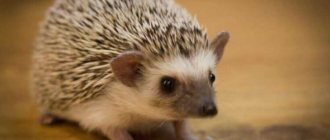Communication
Hamsters are far from the most sociable rodents, since in nature they live strictly alone. At home, keeping a hamster should also be solitary; if there are several animals, then there should be several cages. Such a pet also does not strive to communicate with the owner, so you will have to spend a lot of time taming an independent rodent.
There are certain rules of communication; if they are not followed, the hamster will show fear and aggression, irritating the owner. In the first days after purchasing the animal, it is better not to disturb it at all, no matter how much you want to cuddle the fluffy little ball. It will take about a week to get used to the new home, and at the same time to the voice and smell of the owner. At this stage, it is recommended to say your pet's name while feeding.
Domestic hamsters differ little in temperament from their wild counterparts; they must be patiently trained to be handled so that communication brings joy to both the owner and the pet. With hamsters, the main remedy is food reinforcement - you need to teach the baby to take a treat from the palm of your hand.
Gradually the rodent will get used to the hand, then it can be pulled out of the cage. Handle the animal with care - the tiny animal can be injured if it jumps out of your hands or is held too tightly. The safest thing to do is to wrap your palms around it, forming a “house”.
Contraindicated:
- wake up the animal;
- take from above, from the back (association with a predator attack);
- make sudden movements (even if bitten, you need to remain calm).
Using the wrong bedding
In order for a hamster to feel comfortable and please its owners with its healthy appearance and active games, it needs to choose the right food, change the water often and use the right litter for the cage.
You can find a lot of bad advice on numerous forums on the Internet. For example, that rodents love rags. Bury yourself in them and live there. However, this is not at all true. The rags will quickly absorb dirt and become unhygienic. Besides the fact that it will emit an unpleasant odor, and aromas are important for hamsters.
Other materials such as:
- softwood shavings;
- cat litter.
Good, quality bedding material is very important for your pet. At the pet store you can find:
- Hay. You can not only purchase it, but also prepare it yourself. The hamster will be able to make a nest out of it and even feast on it on occasion. However, its environmental friendliness is not always guaranteed.
- Sawdust. This is an inexpensive and universal litter that is suitable for any rodents. However, due to their very light weight, they will be not only inside the cage, but also outside it.
- Wood pellets. Or pressed sawdust. They absorb odor better than all of the above and are environmentally friendly. However, some types of hamsters will not be comfortable living on the pellets as they are quite large in size. In addition, they contain wood dust, which does not have the best effect on small animals.
- Cellulose filler. Externally, it also looks like granules, but not as large in size as wood. They are the safest and most convenient. But they don't absorb odor so well.
The following compounds are strictly not suitable:
- Newspaper. This filler was used quite widely in the past for lack of anything better. However, printing ink alone can cause irreparable harm to your pet's health.
- Plain paper. The hamster will definitely try it on his teeth and may be injured by the sharp edges.
- Cotton wool. Some people also use this kind of filler, motivated by the fact that it will be a cozy nest. Maybe the house will actually turn out to be quite good, but the fibers of this material can wrap around the paws and cause irreparable harm to the limbs.
The issue of bedding for a small rodent should be taken very seriously.
What is required for maintenance
Proper keeping of a hamster at home can not only improve the well-being and health of the small rodent, but also prolong its life. If you create all the conditions for a comfortable existence, the hamster will live a long and happy life without stress.
To keep a pet hamster you need:
- cell;
- house;
- toys;
- feeders 2 pieces;
- drinking bowl;
- running wheel, ball, maze, playground or tunnel.
When choosing a cage, you need to take into account the number and type of hamsters you plan to keep. It is not recommended to house several hamsters in one cage, but in practice it turns out differently. The minimum cage size for one rodent is 60 by 40 cm. It is important that the bars of the cage are positioned horizontally, since hamsters are very active and love to climb the walls of the cage.
The cage must be selected specifically for small rodents. Since the distance between the rods plays an important role. If you are planning to get dwarf hamsters, choose a distance so that a small hamster cannot fit between them.
To keep hamsters, they often buy a cage. But you can use an aquarium. It is important that the size of the aquarium also corresponds to the minimum size of 60 by 40 cm per pet, and the number of hamsters living.
Under no circumstances should hamsters be kept in cardboard boxes or plastic containers. Hamsters are rodents; their teeth grow throughout their lives. They will instantly chew up a dwelling made of fragile material and run away. Finding and catching an escaped hamster is not an easy task. But besides this, he can also get poisoned.
What plants are dangerous for a hamster?
The owner must carefully ensure that a pet walking in the garden, flower garden or lawn does not inadvertently feast on a poisonous plant. On lawns and front gardens you can find quite a lot of herbaceous and flowering plants that can seriously poison or even kill a small animal. When releasing a rodent into a flower bed or garden, you must first make sure that the following ornamental plants do not grow there:
- hydrangea;
- rhododendron;
- yucca;
- yew;
- caladium;
- oleander;
- black nightshade;
- bean;
- autumn colchicum;
- mountain laurel;
- belladonna.
If the owner thinks that the hamster has tried any of the above plants, then the animal must be immediately taken to the veterinarian. Some garden plants are so poisonous that they can kill a small animal in a matter of minutes. When releasing a rodent into a clearing, lawn, lawn, you need to make sure that the baby does not eat the following wild herbaceous plants:
- lily of the valley;
- whistler;
- celandine;
- buttercup;
- raven eye;
- marigold;
- henbane;
- anemone;
- field poppy;
- hellebore;
- sleep-grass;
- wolf's bast;
- wild rosemary;
- digitalis;
- fern;
- dog parsley;
- Datura-herb;
- sow thistle;
- root fighter.
CAB HEATING TRICKS
- Towel: If your home is very cold or where you live you are experiencing a cold wave, a good way to warm up your hamster cage is to use a warm towel with an iron. All you need to do is take the towel that covers your pet's living room floor, heat the towel to medium heat with an iron, and place it on the floor of the cage, covering it with sawdust. This way you will heat your entire area.
- Prepare a hot compress: If your pet is very cold and you notice that he is still cold, a good solution is to prepare a warm compress. It's very easy to make, all you need is a sock and rice. What you need to do is fill a stocking with rice and tie it in a knot or sew it, put it in the microwave for a minute and place it next to the animal to cover it with. This trick is not suitable for all hamsters, as if your pet is very curious, he will be tempted to chew the stocking, in which case you should remove it as soon as possible, as if your pet swallows the piece, it can cause serious stomach problems. so be careful.
- Thick Fabric: Another good alternative to heating your pet's home is to cover the cage with thick fabric, always being careful not to reach and chew through it, and to ensure there is ventilation in any part of the cage.
DIY harness
If you couldn’t buy a harness of the right size, it’s not at all difficult to make one yourself. No special patterns are required, you just need to carefully look at the harness in the photo, measure your hamster and, according to the size, sew equipment for the rodent. There are only a few factors to consider:
- the fastening must be strong and reliable;
- the material should be fabric or leather;
- It is better to sew a leash and harness from material in bright colors. This is not just beautiful and aesthetically pleasing, but also practical - if the leash falls out of your hands, so that it immediately catches your eye;
- The harness should not be too small or too big.
A DIY hamster harness will be more convenient than a purchased one, because it is made to individual measurements.
For those who have mastered sewing a harness, making a leash for a hamster with your own hands will be a simple matter. You will only need to buy a rope or strong braid of a suitable width and sew on a fastener (carabiner).
Must be taken into account! You need to put a harness on your pet at home! If the hamster resists, it should be distracted with a treat.
Once the animal is outside, the harness will no longer worry him so much - he will have other things to do. If your pet, even on the street, tries to wriggle out for a long time, remove the harness, and does not switch to the environment, you should check again whether the equipment is comfortable for him.
If you carefully choose a leash and harness for your pet, a walk down the street will become a real pleasure for your hamster.
homkin.ru
Is a walk necessary?
Your pet hamster should be given the opportunity to lead an active lifestyle. A large cage and ball will help increase physical activity. Jogging around the room or going outside will be beneficial.
Hamsters are naturally curious, but they experience discomfort when their environment changes. Veterinarians recommend regularly letting them out of the cage, letting them run and frolic in nature, but you need to monitor their safety.
A hamster is a small rodent; by nature it is not inclined to become attached to a person and will not come running when called. Therefore, it is worth limiting the area for walking, he will simply run away. Veterinarians say that you can walk your hamster everywhere, you just have to follow a few recommendations and rules.
GIVE HIM MORE FOOD
During colder winter periods, it is recommended to give our pet more food, because by fattening the animal we will increase its fat layer, which will help it better protect itself from the cold in a natural way.
As a hamster gets fat, its body fat increases and helps protect itself.
Likewise, you should remember that if you notice that your pet has any problems or its behavior has changed, it is better to immediately contact your veterinarian to undergo a full examination and thus rule out that a cold has caused any problems.
Hamsters are very active animals. Hamster owners often ask questions about whether or not they can let their pet go outside for a walk and how to properly walk a hamster without a walking ball.
- Is a walk necessary?
- On the street
- At home
- Walking equipment
- Conclusion
How to properly walk a hamster
Is it possible to put a hamster in a walking ball?
Pet stores sell special walking balls for rodents with small holes for air. Many owners buy these products for their pets to safely walk outside. Using the ball is simple: the lid opens, a hamster is allowed into the hole, the lid closes, and the animal runs around inside the ball to its heart's content. But it should be borne in mind that walking balls are not intended for small hamsters, but for larger rats. A small animal inside the product may feel uncomfortable and have great difficulty moving. The balls are comfortable, ensure a safe walk, but still limit the freedom of the animal.
Taming
The first thing you need to teach your pet before walking your hamster is to accustom it to your hands. Only a tame animal can be released outside without fear that it will try to escape. It is better to start taming from the very first months of a rodent’s life.
If he continues to be afraid of hands, then there is one good way: when pouring food for him, you need to leave your hand near the food - in this case, he will definitely sniff it. Two or three days of such feeding - and he will already get used to the smell of a person. Then you can try feeding him directly from your hand. If the baby is not afraid to eat from his master's hands while he is being stroked with one finger on his furry back, he has already become tame.
Pros and cons of content
Pros of keeping a hamster
- low cost of a hamster;
- low cost of accessories for maintenance;
- takes up little space;
- does not require special care and knowledge;
- does not make noise;
- no wool;
- no need for daily walks;
- you can keep one hamster, without a pair;
- does not pose a danger to both adults and children;
- easy to breed;
- easy to place the babies.
Disadvantages of keeping a hamster
- they sleep during the day and are active at night;
- unpleasant odor if you do not clean up food debris and excrement daily;
- low life expectancy, from 2 to 3 years;
- some individuals hibernate, depending on the species and conditions of detention.
MUST HAVE A BED
Adding toilet paper or blotting paper to your home will encourage your little pet to peck at the paper and create a warm bed for themselves. The only thing you should remember in this case is that the paper should not have a smell, as this is harmful to our hamster and can lead to his poisoning. Likewise, if you want to add a little warmth to your home, place sawdust on your pet's floor. Sawdust, in addition to the fact that it perfectly absorbs odors (mainly urine), is also a good thermal insulator, so your animal will be even warmer in your home.
A bed made of paper and sawdust is a very good option for a hamster to find warmth.
At home
Before letting your hamster run around the house, you need to remove all sharp and small objects, hide or raise all wires so that the animal does not chew them.
Hamsters have small feet but sharp claws. They calmly climb upholstered furniture and curtains. Make sure your hamster doesn't fall.
You can't leave your hamster alone - he might get stepped on.
You can walk at any time of the day, several times a day, using special devices.
Choosing a location for the cage
Often owners do not pay attention to where to place the hamster's cage. This is a rather important point, which affects both the health and life expectancy of the animal.
Things to consider when choosing a location for a cage:
- Avoid direct sunlight on the cage;
- avoid bright light;
- limit access to the cage for other animals;
- avoid drafts;
- there should be no temperature changes in the room;
- do not place under air conditioning;
- do not place near heating devices;
- there should be no strong odors or smoke in the room;
- do not place near a TV, radio, or stereo system;
- do not place the cage in a walk-through area;
- Do not place it in a children's playroom, as hamsters are afraid of sharp and loud sounds.
For the cage you need to choose a quiet, non-passable place. The cage should not be moved frequently. The optimal temperature for keeping hamsters is 20-25 degrees.
It is necessary to install a house in the cage so that the hamster can rest during the daytime and feel safe. Also in the cage you need to put 2 feeders and a drinking bowl. Feeders with drinking bowls must be attached to the bars of the cage, otherwise an active animal will definitely turn over and trample the contents. One feeder is needed for the grain mixture, which is the main feed, the other is needed for succulent feed.
It is worth considering that hamsters are very mobile and active animals. They definitely need to buy and install a treadmill, ball, tunnels, and labyrinths in the cage. Special playgrounds for hamsters are sold, which already include the listed attractions, as well as various toys for the hamster.
Types of leashes
Leashes can be varied:
- leash with collar;
- harness;
- harness-vest;
- walking ball.
A leash with a collar is used for such pets extremely rarely, in cases where the hamster is a large breed. Most often, a hamster collar is used only for decorative purposes (collars with rhinestones, tiny collars with beads, etc. are worn). Taking a hamster for a walk wearing a collar is unreliable; the animal may wriggle out.
hamster leash
A harness is a more reliable option and is recommended for walks. A harness is a piece of equipment that is made of leather and fabric materials and passes through the chest and paws. The simplest type of harness is two small loops connected on the stomach, into which the hamster’s legs are threaded. The clasp and leash are attached to the back of the animal. Getting out of a harness is much more difficult than getting out of a collar.
hamster harness
The harness should be put on so that your little finger fits between the animal’s body and the harness. If you put on such a collar more loosely, the hamster will easily free himself, but if you put it on more tightly, you can harm your pet.
A harness is a vest with a leash attached to the back. A vest harness is considered more reliable than a regular harness. The animal itself feels more comfortable in such a harness.
vest-harness for hamster
Carefully! Collars and harnesses must be securely attached to the leash, otherwise a small animal can simply be lost.
Walking ball - it does not apply to leashes, but this is another suggestion for those who want to walk their hamster.
Typically, this is a plastic ball with holes made for ventilation. Not many owners use such a ball for walking, but in the case of a Djungarian hamster or another dwarf hamster, this is the most convenient solution. If the pet is larger, then it is more convenient to walk on a harness, because the pet does not feel very comfortable in the ball, the space is limited, and there is simply no opportunity to run on the ground. walking ball for hamster
How to properly organize walking a hamster?
How to walk a hamster in the fresh air so that it doesn’t run away, get into trouble, or get injured? If your pet is walking around the front garden, garden or private yard, then you need to make sure that he does not find a loophole in the fence or get out onto a pedestrian street or highway. When releasing an animal from your hands onto the ground, you need to make sure that there are no dogs, cats, rats, crows or other dangerous predators nearby. A hamster is a completely weak and defenseless creature; for predatory animals and birds it can become an easy and tasty prey. Items containing toxic substances and heavy metals should also be removed from the walking area. Painted and varnished wooden products are especially dangerous for your pet. The animal can chew them and get poisoned.











